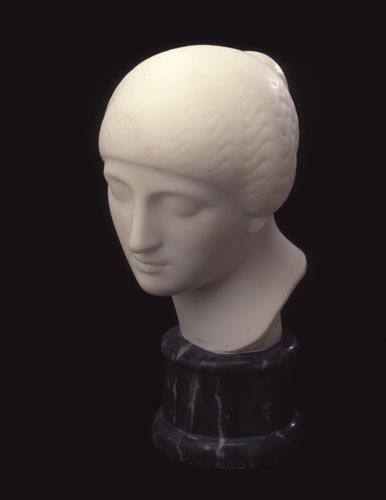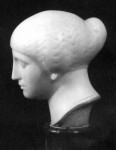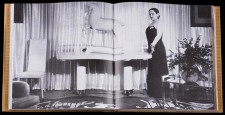


Elie Nadelman
Polish, 1882-1946 (active USA)
Female Head, 1909-1910
white marble
13 1/4 x 12 1/2 x 8 in.
SBMA, Museum Purchase, with funds provided by the Austin Fund in honor of Wright S. Ludington, the Carol L. Valentine Art Acquisition Fund, the Mary and Leigh Block Fund, and the General Art Acquisitions Fund
1999.47

Photographer unknown, Elie Nadelman, ca. 1905-08. Photograph courtesy of the Estate of Elie Nadelman.
"Elie Nadelman, the Polish-American sculptor and graphic artist, evolved a highly distinctive sculptural style by abstracting human forms and stressing the curvilinear interplay of contours." - Encyclopedia of World Biography
RESEARCH PAPER
INTRODUCTION
"... in love with style... the curved line... and sculpture as an elegant game " -- very nearly captures the artist Elie Nadelman. Strikingly handsome and urbane, he carried with him an aura of the well-bred and debonair (think Fred Astaire!). Who was this artist to whom success came early in the Paris avant-garde of Matisse and Picasso, and whose 40-year career would embrace, analyze and expand upon the entire history of Western Art? Influences from the caves of Lascaux, Ancient Greece, Michelangelo, Mannerism, Art Nouveau, Rodin and, finally, Folk Art, wound their way through his drawings, sculptures and carvings. He combined the intimate knowledge of 4000 years of carving and casting with brilliant craftsmanship and the ironic wit of the modernist.
BIOGRAPHY
Elie Nadelman was born in Warsaw, Poland in 1882, a product of Old Europe with its varied cultures and intellectual liberalism. His father was a successful jeweler from whom he inherited a love of fine materials, and his mother's family included artists and writers. A self-taught intellectual he avoided academies, preferring introspective scholarship.
In 1904 he left Poland for Paris, then the center of progressive thought and art, there devoting himself to the roots of sculpture. How was form composed and volume filled and balanced? He analyzed drawings of the human nude and investigated the nature of physical matter, all undertaken as an intellectual and manual discipline. What was the structure underlying form? He placed the emphasis on underlying geometry. Very quickly he became part of the Paris avant-garde, and his first exhibition at Galerie Druet in 1909 was an immediate success. Leo Stein, brother of Gertrude, brought Picasso to Nadelman's studio where he saw a head in plaster created from alternating curves, whose influence on Cubism has been debated since.
In 1911 an exhibition of his work was held at the Patterson Gallery in London, containing 15 marble heads. It created a sensation. Here was neo-classicism based on poses and properties of Greek antiquity, yet not cold. There was a contemporary feeling in the combining of Mannerism and Classicism that resulted in fluidity and elegance. The collection was purchased in its entirety by Helena Rubenstein (Princess Gourielli-Tchkonia), a fellow Pole (yes, she of the cosmetics empire) who became Nadelman's patron, helping him emigrate to America on the eve of World War I.
He arrived in New York a respected artist and quickly became a member of Manhattan's High Bohemia, due not only to his facile talent but to his personal style -- a combination of casual elegance and magnetic physicality (think sex symbol!). He exuded self-confidence and charm, moving easily in the world of artists and society, yet he remained unattached to any master and had his own studio. From his debut even before his first Paris showing he was enthusiastically patronized. His decorative work included a series of animals done in fluid lines, combining cool elegance and nostalgia. As late as 1930 he produced garden figures for wealthy clients. His female nudes embraced a number of styles -- neo-classical, tubular (mannerist), monstrous (over-sized and exaggerated), and Cubist. His later carved figures of contemporary society types were done with style and an ironic wit.
In 1919 he married a wealthy widow, Mrs. Joseph Flannery, and they began amassing a large collection of Folk Art through the 1920's. His work borrowed some of Folk Art's directness and naive qualities, but he imbued his figures with an elegant worldliness and sly wit that makes them some of his most valued works today.
In 1929 their fortune was wiped out. They retired to their estate, Alderbrook at Riverdale-on-Hudson, where he became more reclusive though he never stopped creating. The tiny figures of his later years were done in plaster and terra cotta, influenced by the Tanagra figurines of Ancient Greece; but they are far from graceful, and show dark and unreal distortions, by far the most anti-classical of his career. He died in 1946 surrounded by the creations of his final years.
FEMALE HEAD
The life-size head is carved from white marble and is a smoothly polished surface, soft yet flawless. The lines are symmetrical, the head turning slightly in space, which adds to the harmony of the curved lines. The lips, which neither smile nor frown, are finely chiseled. The nose is aquiline, its angle balanced by the up-tilted chignon, and the hair is stylized in bands of rhythmically repetitive patterning. The eyes are veiled and impassive, suggesting remoteness and ambiguity. More than imitating the classical, the head seems to echo it. This is not a particular divinity or a differentiated individual.
The Hellenic was his criterion, harmonious essence of the impersonal and rational. He did his Greek homework. Yet antiquity was only a pretext and appropriating the past only a starting point; he reduced, domesticated, and modernized the poses and properties of the classical. Every possible presentation of the Greek profile was done in his Ideal Heads series, created in the year 1905-1915. Unfortunately, the only titles given to these figures were general ones: Research in Volume, or Accord of Forms. They were not individually numbered, and establishing a chronology has been difficult. One of the marble heads was given to the Rhode Island School of Design, his first to enter a museum.
In 1911 fifteen of the female heads were exhibited at the Patterson Gallery in London. Purchased by Helena Rubenstein, she mounted the heads in her beauty establishments all over Europe where they became a trademark, a symbol for scientific beautification of the modern woman; marble cheeks are without blemish and not a hair is out of place. They exude luxury and the promise of magic that is beauty -- thus we can gaze at this figure, so enigmatic in its polished perfection, and share nothing but pure pleasure at its execution.
SUMMARY
So how do we view Elie Nadelman's sculpture today? He has come to be seen as out of step with 20th century art with its emphasis on expressionism -- not for him self-pity or the personally tragic (no angst here). Perhaps we have grown so used to contemporary art that repudiates the past, we view him as too controlled and detached. Critics were asking: How could something so methodical and organized be valid? He was so cool and amusing, how could he be modern (no neuroses), so affluent and self-assured, how could he create art? What he adored was traditional craft, sculpture as an intellectual pursuit. He sought "expertise" -- not improvisation or luck and possibility. His virtuosity was based on historic absolutes, yet enlivened by the elegance and wit of the modernist.
Perhaps it is best to close with the artist's own words, from which we gain a sense of the passionate intellectual that he was: “I employ no other line than the curve, which possesses freshness and force. I compose these curves so as to bring them in accord or opposition to one another... the subject of any work of art is for me nothing but a pretext for creating significant form, relations of forms which create a new life that has nothing to do with life in nature, a life from which art is born, and from which spring style and unity.”
Prepared for Santa Barbara Museum of Art Docent Council by:
Karen Webb, March 2004
BIBLIOGRAPHY
Hughes, Robert. American Visions. Alfred A. Knopf, NY, 1997, pp. 341-343. Kirstein, Lincoln. Elie Nadelman, The Eakins Press, NY, 1973.
Kirstein, Lincoln. The Sculpture of Elie Nadelman, Mus. of Modern Art, publication, 1948.
Louis Newman Galleries, Beverly Hills, CA, "Elie Nadelman," June 9-23, 1987.
Nadelman, Cynthia. "The Shocking Blue Hair of Elie Nadelman." American Heritage. March 1989.
Spear, Athena. "Elie Nadelman's Early Heads: 1905-1911, " Allen Memorial Art Museum, Oberlin College, publication, 1971.
Stieglitz, Alfred, Editor. "Statement on Drawings" by artist, Camera Work, No. 32, 1910. Turner, Jane, Editor. The Dictionary of Art, Groves Dictionaries, Inc. 1998.
Zabriskie Gallery, NY, "Elie Nadelman Heads," April 29 - May 24,1980.

Although small, Madame presents a statuesque appearance as she stands by one of Elie Nadelman’s masterpieces, a plaster horse that synthesizes the sculptor’s taste for classical Greek sculpture and American folk art weathervanes. Helena Rubinstein: Extraordinary Style Beauty, Art, Fashion, and Design By Suzanne Slesin
SBMA CURATORIAL LABELS
Born and raised in Poland, Nadelman was a central figure in French early modernism and its translation in America, where he fled after the outbreak of World War II. Worldly and gifted, he circulated easily in the art world of New York and was championed by Alfred Stieglitz, who organized Nadelman’s first exhibition at the legendary Gallery 291 on Fifth Avenue. This elegant sculpture typifies the artist’s work during the Paris period, when he delighted in crafting refined surfaces with gently flowing curves, punctuated by rhythmic incised lines. Like the earlier French symbolist, Puvis de Chavannes, Nadelman’s ambition was to invent an updated classicism based upon Hellenistic prototypes and simplified into his own brand of geometric abstraction.
- Ridley-Tree Reopening, 2021
